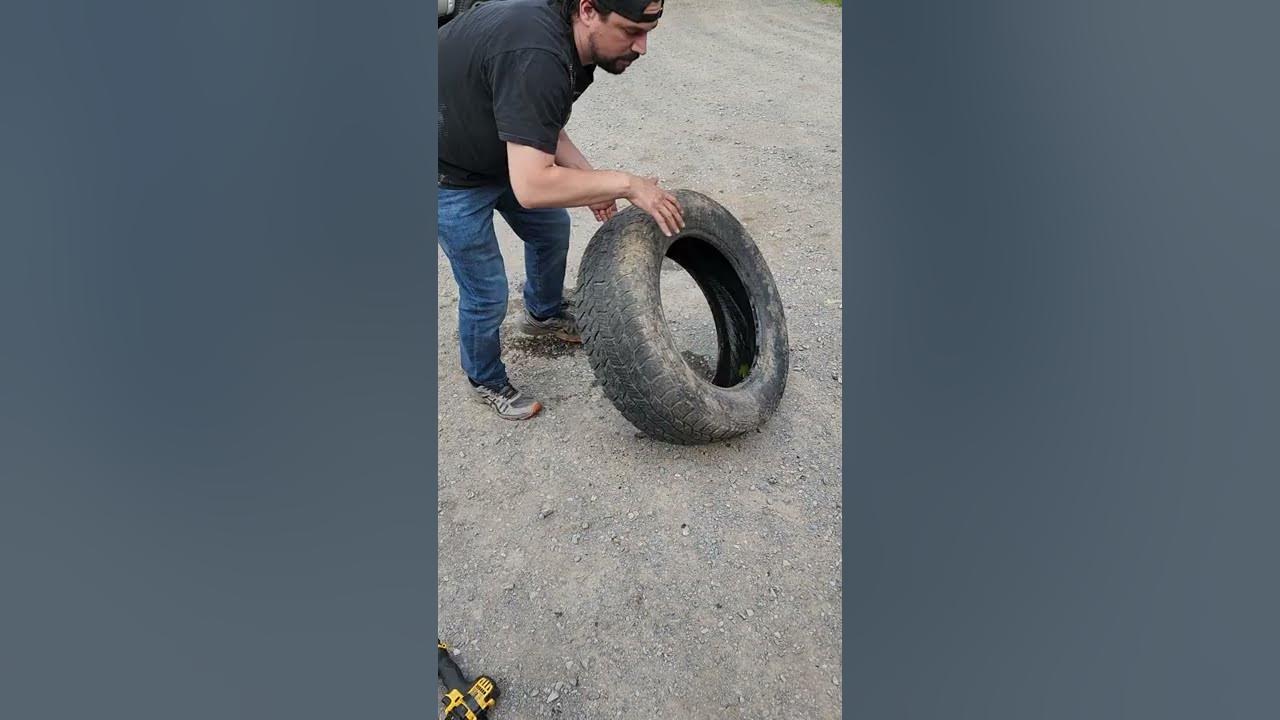How to Get Water Out of a Tire
To get water out of a tire, simply remove the valve stem and allow the water to drain out. This can be done using a valve stem removal tool or by pressing the valve using a screwdriver while the tire is rotated.
When tires accumulate water, it can affect the overall performance and safety of the vehicle. Water in the tire can lead to imbalance, corrosion of the rim, and difficulty in maintaining proper tire pressure. Therefore, it is important to promptly remove water from the tires to avoid potential issues.
We will explore the reasons for water buildup in tires, the potential problems it can cause, and the steps to effectively remove water from tires. By following these steps, you can ensure that your tires remain in optimal condition for safe and efficient driving.

Credit: www.youtube.com
Importance Of Removing Water From Tires
Removing water from tires is essential for several reasons. Failure to do so can lead to tire damage and compromise vehicle performance. Understanding the importance of removing water will help you maintain the longevity of your tires and ensure optimal performance of your vehicle. Let’s delve into the significance of this process.
Preventing Tire Damage
Water inside tires can cause significant damage if not addressed promptly. Moisture buildup can lead to rusting of the metal rims, weakening their structural integrity. This increases the risk of tire failure, especially at high speeds or on rough terrain. Removing water from tires helps prevent rusting, ensuring that your tires remain in good condition for longer.
Moreover, water-filled tires are more susceptible to punctures and leaks. As the water sloshes inside the tire while driving, it increases the strain on the tire walls and tread. This can result in premature wear and tear, reducing the lifespan of your tires. Removing water from your tires eliminates this risk, allowing them to perform optimally and last longer.
Improving Vehicle Performance
Water-filled tires negatively impact the performance of your vehicle. The excessive weight from the water causes increased rolling resistance, making it harder for the engine to propel the vehicle forward. This can lead to a decrease in fuel efficiency, costing you more money in the long run.
Additionally, water inside the tires affects the balance and stability of your vehicle. Uneven distribution of weight can lead to vibration or wobbling sensations while driving, which can compromise your control over the vehicle. By removing water from your tires, you can restore the balance and stability, ensuring a smoother, safer ride.
Furthermore, water-filled tires can freeze in colder temperatures, potentially leading to tire deformation or even bursting. Removing water from your tires in freezing climate is crucial to avoid these risks and maintain the structural integrity of your tires.

Credit: physics.stackexchange.com
Methods For Removing Water From Tires
To remove water from tires, you can utilize a few effective methods. One option is to elevate the tire and rotate it to drain the water out. Alternatively, you can use a compressor to blow the water out of the tire.
These techniques help prevent potential issues caused by water accumulation in tires.
Methods for Removing Water from Tires H3 headings must be in HTML syntax. Removing water from tires is crucial to maintain proper tire pressure and prevent damage. There are several methods for removing water from tires, each with its own benefits and limitations. Here are some effective ways to get water out of tires: Using Tire Valve To utilize the tire valve for removing water from tires, first, locate the tire valve on the rim of the tire. Then, position the valve in the 6 o’clock position to ensure that water will drain out. Once the valve is in position, simply press on the valve stem to release any water that has accumulated inside the tire. Using Gravity Drainage Gravity drainage is another effective method to remove water from tires. Start by lifting the tire onto a stand or other elevated surface. Position the valve at the bottom of the tire to encourage water to flow out. Leave the tire in this position for a period of time, allowing gravity to assist in draining the water from the tire. Using Compressed Air Utilizing compressed air is a quick and efficient method to remove water from tires. Attach a special tool to the tire valve designed for releasing air from tires. Then, apply the compressed air to the tire, which will forcefully expel the water from the inside of the tire. By incorporating these methods for removing water from tires, you can effectively maintain the performance and longevity of your tires.Preventive Measures To Avoid Water Accumulation In Tires
Preventive Measures to Avoid Water Accumulation in Tires
Regular Inspection
Inspect tires regularly for any signs of water accumulation. Look for cracks or damage that may allow water to seep in. Replace any damaged valves or seals promptly to prevent water ingress.
Proper Storage
Store tires in a dry and covered area to prevent exposure to rain and moisture. Use tire covers or waterproof tarps to shield them from the elements, minimizing the chances of water entering the tires.
Avoiding Puddles
Avoid parking vehicles in areas prone to flooding or where puddles frequently form. Prolonged exposure to standing water can lead to water entering the tires, so choosing dry parking spots is essential to prevent water accumulation.

Credit: blog.rcmart.com
Professional Options For Water Removal
A common problem many car owners face is finding water inside their tires. This can happen due to various reasons, such as driving through deep puddles or experiencing a leaking valve stem. If you have noticed water in your tires, it is crucial to address this issue promptly to prevent any further damage. While you may attempt to remove the water yourself, there are professional options available that can ensure a thorough and effective solution. Let’s explore two commonly sought-after professional options: Tire Repair Shops and Mechanic Services.
Tire Repair Shops
Tire repair shops specialize in all things related to tires and can provide expert assistance when it comes to water removal. These shops are equipped with specialized equipment and knowledgeable technicians who can assess the situation and offer appropriate solutions. By visiting a tire repair shop, you can take advantage of their expertise and experience in handling such tire-related problems.
Moreover, tire repair shops have access to air compressors and water extraction tools that can effectively remove water from your tires. Their professionals will inspect the tires carefully, identifying the source of water and ensuring a comprehensive resolution.
Mechanic Services
Another professional option for water removal from tires is seeking the assistance of a mechanic service. Many mechanic shops also offer tire-related services. By consulting with these experts, you can ensure that the water removal process is handled efficiently and effectively.
Mechanic services have the necessary tools and equipment to access the inner components of your tires. They can thoroughly inspect the valves, rims, and the tire itself to identify any underlying issues that may have caused water accumulation.
Additionally, mechanics can also assess the overall condition of your tires, ensuring that they are in good shape and inspecting for any signs of potential damage that may require repair or replacement.
In conclusion, professional options like tire repair shops and mechanic services are reliable choices for water removal from your tires. Their expertise, specialized tools, and equipment can ensure a thorough and effective resolution to this common issue. By seeking professional assistance, you can have peace of mind knowing that your tires are safe and in optimal condition.
Frequently Asked Questions On How To Get Water Out Of A Tire
What If You Get Water In Your Tire?
Water in your tire can cause imbalance, vibration, and corrosion. It’s crucial to remove the water promptly and inspect for any damage or leakage.
How Do You Get Water Out Of Stored Tires?
To remove water from stored tires, use a wet/dry vacuum or a tire siphon pump. Insert the nozzle into the tire and suction out the water. Afterwards, properly dispose of the water and ensure the tires are completely dry before storage.
Can You Use A Tire That Has Water In It?
No, you should not use a tire with water in it. Water can cause damage to the tire and affect its performance and safety. It’s important to keep tires dry and in good condition for optimal use.
How Do You Get Moisture Out Of Inside Tires?
To remove moisture from inside tires, use a special tire valve that allows air to flow out. Connect a air compressor line to the valve and release the air. Repeat this process to remove all trapped moisture inside the tire.
How Does Water Get Into Tires?
Water can enter through leaks or improperly sealed valve stems. ###
Can Water Cause Damage To Tires?
Yes, water can degrade rubber compounds leading to cracks and corrosion. ###
Why Is It Important To Remove Water From Tires?
Water can affect tire balance, accelerate rusting, and reduce tire lifespan. ###
Conclusion
Removing water from a tire is a common challenge faced by many vehicle owners. By following these simple steps, such as deflating the tire, locating the drainage hole, and using a compressor or gravity to remove the water, you can effectively tackle this issue.
Remember to exercise caution and consult a professional if needed. Keeping your tires dry is essential for optimal performance and safety on the road. Stay proactive and maintain your vehicle to ensure a smooth and hassle-free driving experience.


